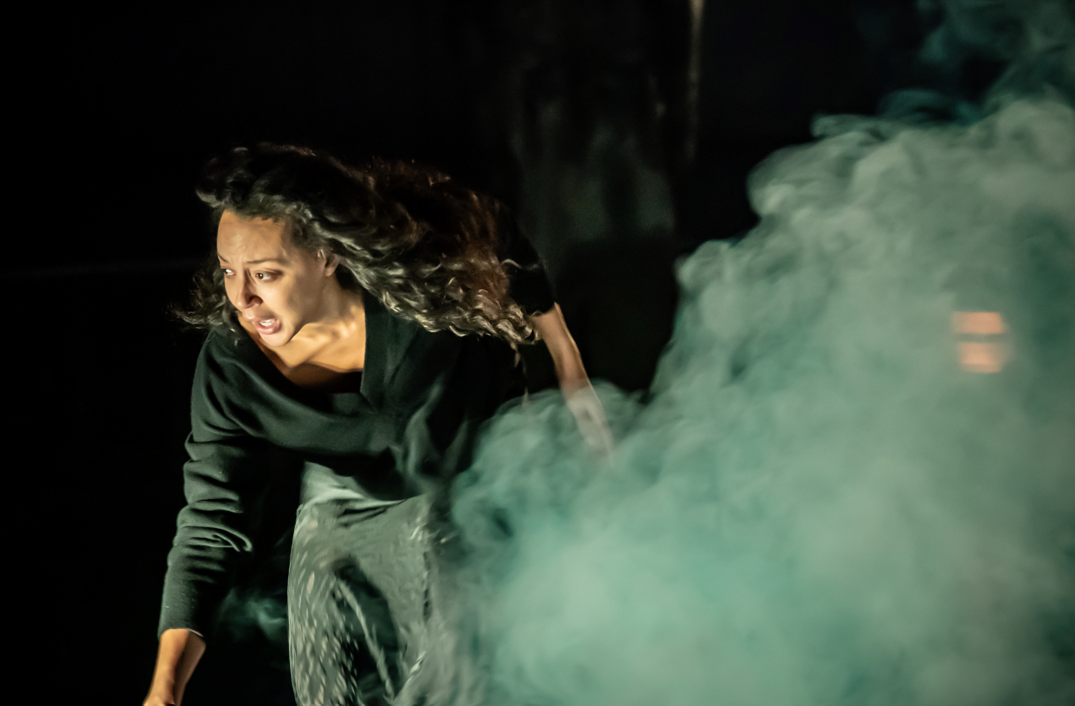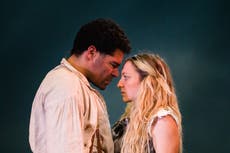Anna Karenina review: Tolstoy’s heroine is brought to magnetic, maddening life by Adelle Leonce
Anthony Lau delivers a stylish production at the Sheffield Crucible, set in a glittering, heightened contemporary world of neon outfits and disco balls. Yet while the first half flies by, something goes awry after the interval

“This is my story”, says Anna Karenina near the start of this stage version of Tolstoy’s epic novel. She is swept away in a passionate love affair, only to realise she’s trapped in the prison of motherhood, marriage, and society’s strict expectations for how a respectable woman should behave. But in fact, this is two people’s story: the relationship at the heart of Helen Edmundson’s stage adaptation (first performed in 1992) isn’t between Anna and her love, Count Vronsky – it is between Anna and Levin, a parallel character whom she doesn’t meet till near the novel’s end.
Here, they circle each other from the start on designer Georgia Lowe’s fabulous Prussian-blue circular set, explaining their lives, their motivations. A neat theatrical contention is established: Anna or Levin ask “Where are you now?”, forming an invitation for the other to effortlessly transport us to a ball in Moscow or a country estate.
But while both characters are trying to work out how to love, and how to live, Levin’s story always feels secondary, especially in a second half that manages to feel both rushed and far too long. Anthony Lau delivers a stylish production, set in a glittering, heightened contemporary world of neon outfits and disco balls. Yet while the first half flies by, something goes awry after the interval. The pace stutters, as Anna stumbles towards her infamous death under a train – heavily foreshadowed in sound, lighting and in black paint-smeared figures that haunt her.
Fortunately, the show boasts a vivacious, pungent performance from Adelle Leonce as Anna: this Emilia alumnus makes Tolstoy’s heroine magnetic, maddening, manipulative… and utterly sympathetic. You are with her, every step of the journey. Douggie McMeekin is endearing as Levin, although the decision to amp up his self-pitying pomposity and to mock his Tolstoyan urge to embrace the simple life, working on the land, leaves something missing at the heart of the performance. Both Anna and Levin’s desperate search for meaning should probably, well, mean something.
Still, it’s for the best that it is their interaction that drives the production, as the casting of Vronsky is a misstep. Chris Jenks, who plays the lovably dim Steve in Sex Education, seems to almost reprise that role: Vronsky may be young, but he’s meant to be an irresistible army officer, not an awkward schoolboy. The chemistry between Jenks and Leonce is choreographed in cliche little dance sequences; I don’t buy it.
Lau has fun with a supporting cast, creating a shallow, sequin-spangled Moscow society. Hedonism is symbolised in the conspicuous consumption of cake that ends up all over the stage. It’s gleefully messy, and speaks of a director not afraid to take risks with a classic. But there is a disconnect between the sneery, dayglow tone of these set pieces – days at the races and nights at the club – and the deeply felt tragedy of the main plot that Lau hasn’t reconciled. I also wish they’d been bolder with the script: there’s a jar between Edmundson’s period drama register, and the zany setting and modern speech patterns.
What does work triumphantly is the design. Alexandra Faye Braithwaite’s sound is evocative, especially the anxious beats that blend racing heart and approaching train. Jack Knowles’ beautiful, carefully delineated lighting is constantly shifting, whipping us between external locations and inside Anna’s tortured mind. It works perfectly with Lowe’s set – light slicing through seven doors along the back wall, a circular rig descending like a cage. The swiftly moving action could so easily feel adrift on this stage, but Lowe wraps the cast in a rich blue, and lets them circle each other – an appropriate visual for Tolstoy’s stuck, spiralling characters.
Join our commenting forum
Join thought-provoking conversations, follow other Independent readers and see their replies
Comments


Bookmark popover
Removed from bookmarks